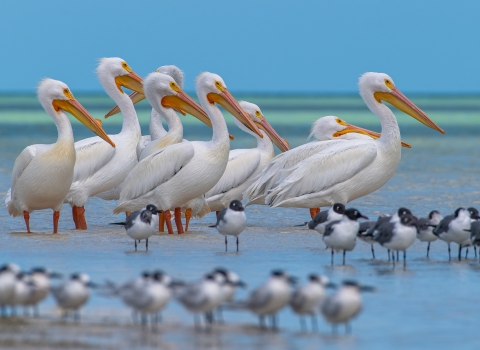What is Mitracarpus polycladus?
Mitracarpus polycladus is a small shrub that is known to occur in aggregations where soil and water accumulate on exposed limestone areas.
Where is Mitracarpus polycladus found?
At the time of listing in 1994, M. polycladus was only known to occur in two populations, Puerto Rico and Saba Island (The Netherlands) with an unknown number of individuals. The Service is now aware of over 20,000 individuals in three populations – Puerto Rico, Saba Island and Anegada Island (British Virgin Islands). About 89% of the plants in the Puerto Rico population occur in areas managed for conservation, where threats due to habitat modification from urban development are substantially reduced. The remaining 11% of M. polycladus in Puerto Rico and the plants on Saba and Anegada Islands occur on private property and are more vulnerable to the threat of urbanization and development.
What action is the U.S. Fish and Wildlife Service proposing?
The Service is proposing to reclassify M. polycladus from endangered to threatened under the ESA due to successful conservation efforts. The Service is also proposing a 4(d) rule that tailors take prohibitions to those that provide conservation benefits for the species. This proposed 4(d) rule would apply the prohibitions for endangered plants with standard exceptions to the prohibitions to allow partners to work with cultivated seeds on recovery actions.
Why is the Service proposing a reclassification of Mitracarpus polycladus?
The Service completed 5-year reviews in 2011 and 2018 with recommendations to reclassify the species from endangered to threatened.
The ESA defines an endangered species as one in danger of extinction, and a threatened species as one likely to become endangered within the foreseeable future. Based on evaluation of the best available scientific and commercial information, the Service has determined the species’ status has significantly improved and no longer meets the definition of endangered under the ESA, but it does meet the definition of threatened.
What are the threats to Mitracarpus polycladus?
The primary threats to M. polycladus are habitat destruction and modification due to road and trail maintenance, trampling by humans, human-caused fires, non-native invasive species invasive species
An invasive species is any plant or animal that has spread or been introduced into a new area where they are, or could, cause harm to the environment, economy, or human, animal, or plant health. Their unwelcome presence can destroy ecosystems and cost millions of dollars.
Learn more about invasive species , urbanization and tourism development, and the effects of climate change climate change
Climate change includes both global warming driven by human-induced emissions of greenhouse gases and the resulting large-scale shifts in weather patterns. Though there have been previous periods of climatic change, since the mid-20th century humans have had an unprecedented impact on Earth's climate system and caused change on a global scale.
Learn more about climate change .
What conservation actions have been undertaken for Mitracarpus polycladus?
Multiple partners have been working with the Service on recovery efforts for M. polycladus, including the Puerto Rico Department of Natural and Environmental Resources (PRDNER) and the Royal Botanic Gardens (Kew), in collaboration with the National Park Trust of the Virgin Islands. The Service will continue to work with PRDNER and private landowners and other partners on the monitoring and surveying of unexplored M. polycladus habitat to develop sound conservation strategies and proactively identify priority areas for conservation.
The Service also encourages continued surveys in areas critical to M. polycladus survival, and further conservation agreements, including the development and implementation of conservation measures to avoid or minimize adverse effects on the species and its habitat.
What is a 4(d) rule?
For a threatened species, the Service uses the flexibility provided under the ESA’s section 4(d) to tailor take prohibitions to those that provide conservation benefits for the species. This targeted approach can reduce ESA conflicts by allowing some activities to continue that may benefit and not significantly harm the species, while focusing efforts on the threats that slow the species’ recovery. These customized protections minimize the regulatory burden while maximizing the likelihood of recovery for threatened species.
The proposed 4(d) rule for M. polycladus would apply the prohibitions for endangered plants (50 CFR 17.61) with standard exceptions to the prohibitions to allow partners to work with cultivated seeds on recovery actions.
What kind of information is the Service requesting from the public with this proposed reclassification?
The Service is seeking comments regarding:
Reasons we should or should not downlist Mitracarpus polycladus as a threatened species;
New information on the historical and current status, range, distribution, and population size of Mitracarpus polycladus;
New information on the known and potential threats to Mitracarpus polycladus including habitat modification or loss or climate change;
New information regarding the life history, ecology, and habitat use of Mitracarpus polycladus;
Current or planned activities within the geographic range of the Mitracarpus polycladus that may have adverse or beneficial impacts on the species;
Information on regulations that are necessary and advisable to provide for the conservation of the Mitracarpus polycladus that the Service can consider in developing a 4(d) rule for the species; and
Information concerning the extent to which we should include any of the ESA section 9 prohibitions in the 4(d) rule or whether any other forms of take should be excepted from the prohibitions in the 4(d) rule (to the extent permitted by Commonwealth law).
How do I submit comments on this proposal?
The Service will accept comments on this proposed rule at www.regulations.gov (search for docket number FWS-R4-ES-2021-0058) until August 22, 2022. Requests for public hearing must be received by August 8, 2022 at the address listed below.
FOR FURTHER INFORMATION CONTACT: Edwin Muñiz, Field Supervisor, U.S. Fish and Wildlife Service, Caribbean Ecological Services Field Office, Caribbean_es@fws.gov; telephone: 787-851-7297. Persons who use a telecommunications device for the deaf (TDD), may call the Federal Relay Service at (800) 877-8339.


